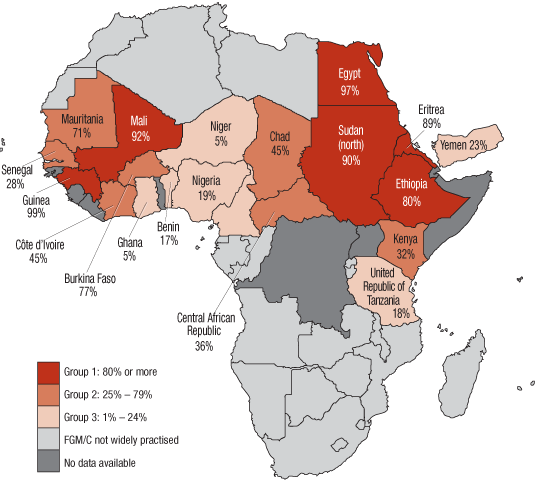Female Genital Mutilation (FGM), also known as Female genital cutting or female circumcision, is any procedure involving the partial or total removal of the external female genitalia or other injury to the female genital organs “whether for cultural, religious or other non-therapeutic reasons.” [1]FGM is a cultural practice that originated in Africa approximately 2000 years ago. Today the prevalence of FGM is widespread in Africa and in some countries in the Middle East and Far East Asia. It is also practiced among immigrant communities in the US and Europe. An estimated 135 million girls and women have undergone genital mutilation. [2] Two million girls are at risk each year – that’s approximately 6,000 girls per day who will undergo this heinous procedure. The practice of FGM is so deeply ingrained into the cultures that practice it, that it defines members of these cultures. In order to counteract FGM, it is essential to understand in deeper detail, this phenomenon and the cultural/religious ideologies that endorse it. This paper examines the practice of Female Genital Mutilation, its causes, effects and consequences, as well as its prevalence and the international response to combat it.
The Procedure
Female Genital Mutilation involves the removal of all or just part of the external parts of the female genitalia. The World Health Organization (WHO) and various United Nations (UN) groups classify FGM into four types. [3]

FGM is commonly performed without anesthesia with razor, scissors, sharp rocks, broken glass, and/or pieces of tin.
Type I: Partial or total removal of the clitoris and/or the prepuce. This procedure is called Clitoridectomy.
Type II: Partial or total removal of the clitoris and the labia minora, with or without excision of the labia majora. This procedure is called Excision or Sunna circumcision (Sunna in Arabic means “tradition”)
Type III: Narrowing of the vaginal orifice with creation of a covering seal by cutting and appositioning the labia minora and/or the labia majora, with or without excision of the clitoris. This procedure is called Infibulation or Pharonic circumcision.
Type IV: All other harmful procedures to the female genitalia for non-medical purposes, for example: pricking, piercing, incising, scraping and cauterization.
The age at which a girl undergoes FGM varies from just after birth to during the first pregnancy, although it is most frequent between the ages of four and eight. The practice is mostly carried out by traditional circumcisers, with no medical training and anesthesia. Increasingly, however, FGM is being performed by health care providers. The instruments used to perform this procedure is any sharp object, including razor blades, knives, scissors, broken glass or even a tin lid. These items are usually not sterilized before or after usage. The subsequent raw wound is then stitched together using string, thorns or even cat or lamb intestines, leaving a small opening for the passage of menstrual flow. The child’s legs are then bound together for up to two months for the wound to heal over, immobilizing her over the recovery period.
Health Effects
Female Genital Mutilation has absolutely no health benefits and on the contrary, has significant negative health implications. Immediate complications include severe pain, shock, tetanus or sepsis, hemorrhage, urine retention, open sores and injury to the genital region. [4]Long-term consequences can include bladder and urinary tract infections, depression, sexual dysfunction, kidney stones, infertility, benign nerve tumors, and various obstetric and gynecological problems. Sometimes FGM is practiced as a group rite on many girls at once and often using the same cutting tool. This can easily cause the spread of HIV and other communicable diseases.
Women are continually cut open for childbirth and re-infibulated afterwards, to make them desirable for their husbands for intercourse. This repeated process leads to the formation of a thick scar tissue which makes childbirth excruciatingly painful. It is also dangerous for the mother since it prolongs labor, blocks the birth canal and often causes perianal tears. The ill effects of FGM are rarely blamed on the practice or the practitioner, but instead on the girl who undergoes the procedure. Often times witchcraft or the inadequate performance of rituals associated with the procedure are blamed. [2] FGM victims also have a high suicide rate.
Social, cultural and religious causes
Female Genital Mutilation is a culture identity practice and defines who is part of the society. This fact is obvious in the numerous cultures that carry out this procedure as an initiation into womanhood. People in such a society feel that the restriction of FGM would lead to the demise of their culture and the procedure must be carried out in exactly the same way it has been done over the ages.
The causes of FGM comprise of an assortment of social, cultural and religious factors within families and communities. The leading claims of why this procedure must be done include:
- The belief that FGM will reduce a women’s desire for sex and in doing so will reduce the chance of sex outside the marriage. This is vital to this society as her honor for the family is depended on her not to be opened up prior to marriage. When FGM is performed, the fear of pain of opening the vaginal orifice and the fear of this being found out, is expected to further discourage “illicit” sexual intercourse.
- Where FGM is widespread, the social pressure to conform is a strong motivation to continue the practice. Local structures of power and authority, such as community leaders, teachers, religious leaders, and even some medical personnel can promote FGM.
- FGM is often considered a necessary part of raising a girl properly, and a rite of passage to womanhood. In these societies, FGM is seen as a preparation for marriage.
- FGM is associated with the cultural principles of femininity and modesty. Some view the clitoris and the labia as male parts on a female body, thus removal of these parts cleanses and enhances the femininity of the girl. Some societies believe that unless a girl has undergone this procedure she is unclean and will not be allowed to handle food or water and take part in cultural activities.
- Some practitioners believe the practice of FGM has religious support.
- Some societies believe that removing the clitoris has medical benefits including preventing vaginal cancer, increased fertility and elimination of genital odors.
- Certain groups believe that an unmodified clitoris can lead to masturbation or lesbianism.
- Some cultures hold the belief that if the clitoris touches a man’s penis, the man will die. These cultures usually also believe that a baby dies if its head touches the clitoris, and an intact clitoris causes breast milk to be poisonous.
Gender Stratification & Human Rights Violation
Female Genital Mutilation is deeply rooted in a culture of discrimination against women and linked to the disparate role of women in the social, economic and political structures of the populations that practice it. FGM is a violation of human rights that forces women into prescribed gender roles within the family and community. Women who do not comply with norms of FGM in such societies are

FGM procedures are usually carried out by women. The women who do it have already had their clitorises removed or terribly damaged.
frequently ostracized by their communities. FGM societies reaffirm women’s relegation to the domestic sphere and reduce them to objects of the male sexual fulfillment and mere child-bearers.
Female genital mutilation violates a series of well-established human rights principles, norms and standards, including the principles of equality and non-discrimination on the basis of sex, the right to life when the procedure results in death, and the right to freedom from torture or cruel, and inhuman or degrading treatment or punishment. [3]
Female Genital Mutilation has been recognized as a violation of the human rights of girls and women by the United Nations which has repeatedly called upon governments to strive for the full respect, protection and fulfillment of these rights. Since FGM is usually performed on young girls it is a grave violation of Children’s Human Rights. FGM is just one of many forms of social injustice that women suffer worldwide and should not be viewed in isolation, but as a thread in the broader fabric of women’s rights violation.
International Response

This map was developed by UNICEF to show the prevalence of female genital mutilation among the different countries in Africa.
There are an estimated 135 million girls and women worldwide, who have undergone FGM. This procedure is practiced in Africa (28 countries), Middle East, parts of Asia as well as in the Americas and Europe. Due to its global prevalence, an international response is required to counteract FGM.
During the UN Decade for Women (1975-1985), a UN Working Group on Traditional Practices Affecting the Health of Women and Children was created and it helped develop the 1994 Plan of Action for the Elimination of Harmful Traditional Practices Affecting the Health of women and Children. The World Health Organization (WHO), the United Nations Children’s Fund (UNICEF) and the United Nations Population Fund (UNFPA), unveiled a plan in April 1997 that would bring about a major decline in FGM within 10 years and the complete eradication of the practice within three generations. Since then a lot of progress has been made at both the international and local levels including:
- A wider international involvement in creating awareness of FGM and its eradication.
- The development of international monitoring bodies and resolutions that condemn the practice.
- The establishment of legal frameworks and growing political support to end FGM.
- An upheaval of the role of women in the society, leading more women to deny undergoing FGM.
The Future of FGM

A group of women and children gathered in Lunsar in Sierra Leone to listen to anti-female genital mutilation campaigners urging practitioners to give up the practice.
A collective international response is essential to the eradication of this practice, but a grassroots movement to increase awareness within communities is vital too. An increased understanding of the practice of FGM and the social, cultural and religious causes of it is required to be able to reach the societies in which FGM is prevalent. More importantly, women and children in these societies have to be empowered to create for themselves avenues through which they can speak out against the violation of their own rights and transform the very society that has subjugated them. A dynamic for positive change must be set in motion that will change social norms and accept into society, women who have not undergone FGM. When a large enough number of people take part in this social movement, they can protect each other’s social status and the relinquishment of FGM will become self-sustainable. In the words of Dr. Marcy Bowers, one of the few US doctors specializing in treating FGM victims, “Somewhere, at some point, women have got to hold hands and say, ‘No, no more. We’re not going to do this anymore.” [5]
References
[1] Definition used by the World Health Organization (WHO)
[2] Female Genital Mutilation: A Fact Sheet – Amnesty International
[3] Eliminating female genital mutilation – OHCHR, UNAIDS, UNDP, UNECA, UNESCO, UNFPA, UNHCR, UNICEF, UNIFEM, WHO interagency statement
[4] Female genital mutilation – WHO Fact sheet number 241, Feb 2010
[5] Dr. Marci Bowers of Trinidad one of few U.S. Doctors to Specialize in Treating Female Circumcision Victims – The Huffington Post
